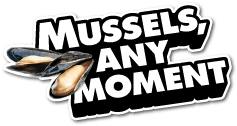Mussel seed, raw material for mussel cultivation
Mussels are grown from mussel seed. The mussel growers obtain this mussel seed in two ways: through regulated seed fishing and, increasingly the case since a couple of years – through mussel seed capture installations. Mussels reproduce in April – May, when the water temperature rises and they start spawning.
Mussel seed through fishery
The traditional fishing for wild mussel seed takes place in the Wadden Sea, in the Eastern Scheldt and in the Dutch coastal waters of the Voordelta. Twice a year, in May and October, growers are allowed to harvest a specified amount of mussel seed at designated beds for a couple of weeks. Every spring and autumn, researchers from Wageningen Marine Research (commissioned by PO Mosselcultuur and the Ministry of Economic Affairs) assess the amount of mussel seed that is present at the designated beds. Next, the mussel growers apply for a permit from the Ministry of Economic Affairs granting them permission to catch some of this seed, taking into account the food needs of birds and allowing space for the development of old mussel beds. The mussel seed that is caught is next transferred to nurseries.
Sustainable sector
The cultivation of mussels has a low ecological footprint. To protect the Wadden Sea and the Eastern Scheldt – both important natural areas – strict conditions apply to the fishing for and cultivation of mussel seed. Furthermore, mussel growers are increasingly adopting alternative approaches. For example, mussel seed is increasingly caught using so-called mussel seed collection facilities. Mussel fishery has been recognised as a sustainable form of fishery by the Marine Stewardship Council (MSC) and may therefore carry the MSC certification mark.
Mussel seed capture installations
Since 2009, mussel seed has increasingly been obtained through so-called mussel seed capture installations (abbreviated as MZIs in Dutch). In 2016, MZIs accounted for 32 percent of all seed. For years, mussel growers have been investing in the development of these well-functioning systems. The introduction of MZIs is the practical outcome of a covenant from 2008 between the mussel growers and the Wadden Sea Association, the Society for the Protection of Birds, Stichting Wad, Natuurmonumenten (Dutch Society for Nature Conservation) and the government. According to this covenant, the mussel sector will gradually decrease its dependence on natural mussel seed in the Wadden Sea. Old mussel beds are avoided.
A mussel seed capture installation consists of nets or ropes which are suspended in the water. Mussel larvae attach themselves to these nets and ropes and grow into baby mussels of one to two centimetres. This is the mussel seed. Each year, the MZIs are positioned in the water from the 1st of March to the 1st of November. In summer and autumn, harvesting takes place one or more times.
Mussel seed from MZIs is a sustainable and efficient alternative to the collection of mussel seed from the bottom. The new technique for seed harvesting increases the business security of mussel growers and reduces their dependency on the natural seed fall in allocated beds. At the same time, the mussel seed capture installations which are currently in use in the Eastern Scheldt, the Voordelta coastal region and the Wadden Sea have resulted in considerable cost increases.
